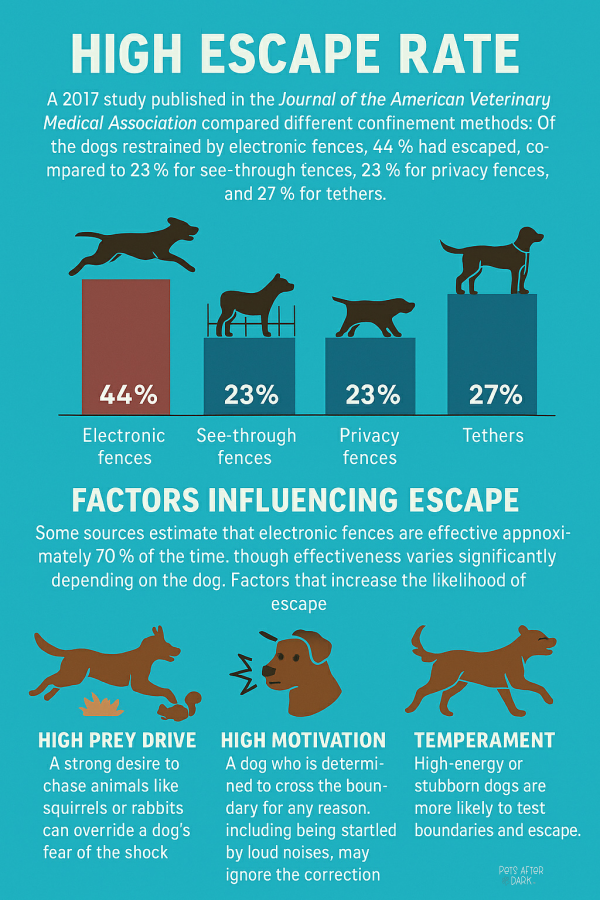
Holiday Joy for Pets: The ‘Yes, They Can Have That’ Edition
Every year around this time pet owners are warned about toxic foods and holiday hazards. And while it’s important to
Weeknights 7PM - Midnight
Weekends 8AM - Midnight

Last week a dog was brought into our clinic after being hit by a car. Accidents happen, and although the dog needed hospitalization for a pneumothorax, pulmonary contusions and a few abrasions, this is a story that ends well.The dog was sent home the next day and is currently making a full recovery.
The reason I bring this up is because of the way this accident happened: the dog was in his front yard by a busy street seemingly protected by an electric fence. Someone was walking their own dog on the other side of the street and our patient ran across the street in the path of an oncoming car despite the electric fencing.
Which brings me to today’s topic: my ill feelings about electric fences!
The case I just described perfectly illustrates the fundamental flaw in electric fence technology. Dogs experiencing high arousal—whether from prey drive, excitement, or fear—can completely override their conditioned response to the electric stimulation. The neurological response during these high-stimulus events is so powerful that it can make the avoidance behavior the fence is designed to create simply disappear.
Over the years, I’ve treated numerous dogs who charged through electric fences to chase cats, other dogs, or wildlife. Some have broken containment during thunderstorms or fireworks when their fear response overrode their fence training. Others escaped when confronted with unfamiliar people or animals approaching their territory. In each case, the electric fence failed precisely when the dog needed protection most.
What makes this particularly dangerous is that many owners develop a false sense of security. They believe their dog is safely contained, so they may not supervise as closely as they would with other containment methods. When that critical moment comes—like seeing another dog across a busy street—the fence becomes irrelevant, but the supervision that might have prevented tragedy is absent.

Electric fences create another fundamental safety flaw that I see regularly in my practice: they may prevent dogs from leaving when they work, but they provide absolutely zero protection from threats entering the property: wildlife encounters with coyotes or aggressive raccoons, and attacks from unleashed neighborhood dogs. We’ve even seen cases involving human-related threats where strangers entered properties with malicious intent.
What makes these situations even worse is that the electric fence actually prevents the dog from escaping to safety. A dog being attacked by a coyote in their own yard can’t flee because they’ve been conditioned to fear crossing the boundary. They become sitting ducks, trapped by the very system that was supposed to protect them.
According to Kelly Wilson, a Certified Professional Dog Trainer with CCPDT and certified veterinary technician to boot, some behavioural issues linked to electric fence use like fear of the yard area, reluctance to go outside , anxiety triggered by electronic beeps (microwaves, phones, alarms) have been seen in dogs. Furthermore increased reactivity to passerby or barrier frustration have been seen to lead to aggressive displays.
She also knew a dog who’s neck got burned from the collar and even worse, related an event where a dog was stolen from his yard because his owners only had electric fencing. She ended her statement by saying: “ I hate the invisible fence”. ( it’s not just me!)
Electric fence systems depend on multiple components working perfectly, and in my experience, something is always going wrong. Power failures during storms or outages can disable the entire system. Battery depletion often occurs without any clear warning to owners—I can’t tell you how many times I’ve heard “I had no idea the battery was dead” after a dog has escaped.
Wire breaks happen frequently from normal lawn maintenance, severe weather, or simple ground settling over time. Signal interference from other electronic devices can also disrupt the system’s function. When any of these components fail, dogs suddenly have unrestricted access to dangerous areas, and owners often don’t realize the containment is compromised until it’s too late.
I remember one case where a dog had been successfully contained for over a year. During a severe thunderstorm, the underground wire was damaged, but the family didn’t discover this until their dog was found two miles away the next morning, dehydrated and terrified. The owners had no idea their “fence” had been non-functional for hours.
When clients ask me about containment options, I always advocate for solutions that provide real, reliable barriers. Traditional physical fencing offers dependable containment regardless of weather, power outages, or equipment malfunctions. More importantly, it provides genuine protection from external threats while giving owners visual confirmation that their containment system is intact and functional.
For situations where traditional fencing isn’t feasible, I recommend supervised containment options. Long-line systems using 10 to 50-foot leashes allow dogs supervised outdoor time while maintaining control. Secure runs can provide enclosed areas for unsupervised yard access, and there’s simply no substitute for direct supervision when dogs are enjoying outdoor activities.
Property management can also help create natural barriers. Strategic landscaping using hedges, gardens, or other natural obstacles can help contain dogs while enhancing rather than detracting from property aesthetics. Sometimes the solution involves changing our approach entirely—scheduling more structured walks, visiting dog parks, arranging playdates, or creating more engaging environments within smaller, securely contained areas.
The dog from last week’s case is recovering and will be fine. As a veterinarian, I’ve seen too many preventable injuries and near-misses to recommend a containment system that fails when dogs need protection most.
Electric fences might seem convenient but convenience should never come at the expense of safety. When it comes to protecting our beloved companions, there’s no substitute for physical barriers and responsible supervision. Your dog’s life is worth more than the convenience of an invisible fence, and they deserve protection that actually works when it matters most.

Every year around this time pet owners are warned about toxic foods and holiday hazards. And while it’s important to

Life on the Inside: How to Keep Indoor Cats Happy (and Out of Trouble) There’s something fascinating about how differently

Do dogs really experience the same “vacation exhaustion” that we do, even when they’re having fun? Turns out, science says yes—kind of.
Pets After Dark is a subscription-based service that provides expert, local after-hours veterinary care.